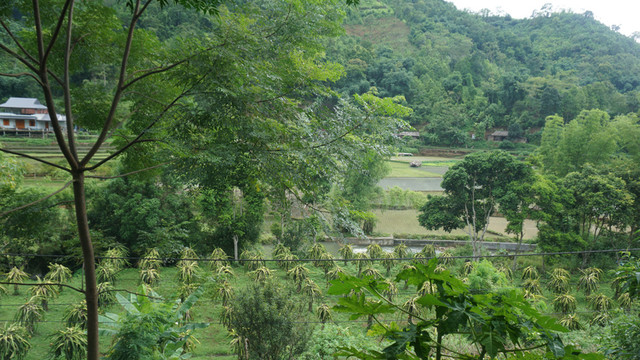Struggling, silenced and (barely) surviving the perfect typhoon
Queer environmental academic-activist Joel Mark Baysa Barredo reflects on how to address the systemic oppression and challenges faced by LGBTQIA+ people in Southeast Asia.


Amid the downpour, the LGBTQIA+ community stands at the forefront of environmental rights advocacy (Photo: Mark Fischer, via Flickr, CC BY-SA 2.0 DEED)
I am writing this blog on the outskirts of Bangkok where, just 14 years ago, we could correctly predict light rainfall at around 4pm. It was, back then, a pleasant end to the day.
Sadly, this is no longer the case. While I remain safe, dry and privileged, those living on the margins of our societies are disrupted by frequent and protracted flooding, droughts and heatwaves. My beloved Southeast Asia is in the middle of a perfect typhoon.
The COVID-19 pandemic – which was both a result and cause of environmental emergencies – deepened vulnerabilities and widened disparities in our societies, proving that our lived inequalities can greatly impact our survival. LGBTQIA+ persons are unwillingly placed at the frontline and crossfire of intersecting challenges, with many of us unable to enjoy dignity, rights or freedoms, our voices and stories ignored, silenced or – worse – unaccounted for.
But now that Southeast Asia is seemingly transitioning to a ‘new normal’, what have we learned about addressing systemic oppression and challenges? Have the powerful and well-resourced become more aware of – and empathic to – affected communities? Or will queer people continue to cling on at the margins?
Environmental and gender rights
The Association of Southeast Asian Nations (ASEAN) prides itself on promoting and committing to “unity in diversity” (PDF) in pursuit of peace, progress and prosperity.
And while our multiple and intersecting realities, beliefs and identities are a strength, our people have also long faced multiple and intersecting challenges – from the rise of authoritarianism to territorial disputes, armed conflicts, economic deprivation and social inequalities. And increasingly, our fragile populations are united in suffering and uncertainty in the face of environmental emergencies.
ASEAN member states take environmental challenges and stresses seriously, forging several commitments over the last 40 years, including the ASEAN Charter (PDF), which provides a mandate to promote sustainable development and protect the environment and natural resources. They have also taken steps to futureproof the region, with the ASEAN socio-cultural community vision 2025 setting priority areas in conservation of sustainable management of biodiversity and natural resources, promoting environmentally sustainable cities, responding to climate change and ensuring sustainable consumption and production.
The ASEAN human rights declaration enshrines our right to a safe, clean and sustainable environment (article 28f). And in recent years, the ASEAN Intergovernmental Commission on Human Rights (AICHR) has led efforts to achieving a regional framework for the fulfilment of environmental rights in the region. At the heart of this is the recognition of the plight and participation of marginalised sectors, and gendered environmental impacts have increasingly become a cause for concern, with issues affecting women and girls receiving tremendous attention, platforms and resources from member-states and sectoral bodies.
Redefining unity in diversity
On the surface, regional commitments and action on the environment, human rights and gender appear impressive. But on closer inspection, deep and dangerous cracks appear. There are limits to the way the region appreciates, addresses and celebrates unity in diversity. And we LGBTQIA+ peoples know this best, as our duty bearers continue to sideline and silence our identities and issues.
Informed and influenced by ‘sociopolitical and cultural sensitivities’, ASEAN has consistently taken a conservative and defensive position on sexual orientation, gender identity and expression, and sex characteristics (SOGIESC). This has had grave ripple effects on the region’s approach to the nexus between gender, human rights and environmental protection.
Language in official documents takes a binary approach to sex and gender, limiting the scope of the lived experiences it recognises and addresses. For example, the State of Gender Equality and Climate Change in ASEAN only covers environmental impacts on women and girls, a lack of recognition that prevents LGBTQIA+ peoples from formally interacting and collaborating with member states and sectoral bodies. Regional SOGIESC groups have tried to be visible and heard, but to no avail.
So, without our data and voices, targeted interventions and resources remain a distant aspiration.
Building a safe, healthy and brave queer environment
As a long-standing regional activist and critical observer, I admit that prospects for a queer-centred environmental rights agenda are far-fetched. But my lived experiences and passions are untainted and unfazed. I see this transformation to a new normal as a platform to slowly, yet fabulously change regional and national structures and norms by:
- Queering allies: there is an emerging movement of potential champions who are willing to accommodate and tackle SOGIESC issues. Some members of AICHR and other sectoral bodies have already allowed LGBTQIA+ activists to participate in national and regional meetings. This should be celebrated and encouraged. Coordinating with the ASEAN Secretariat can help us influence the agenda and knowledge shared with regional decision makers
- Queering partners: by making organisations that work on environment, gender and human rights issues strongly aware of lived LGBTQIA+ experiences and challenges, we can urge them to co-strategise and co-design advocacies and activities, thus normalising, mainstreaming and socialising SOGIESC across programmes and communities, and
- Queering our movement: placing affected LGBTQIA+ community members at the heart of our environmental rights work gives us platforms for expressing our narratives safely and bravely. By passing the mic to the most silenced and invisible, actions against climate injustice will become more inclusive and meaningful.
As I write this article, heavy rain falls outside. But despite the changes in our weather patterns, I write with renewed hope, that I have not only helped to question and redefine the principle of unity in diversity, but also inspired solidarity with our queerblings, so we can weather this perfect typhoon together.



